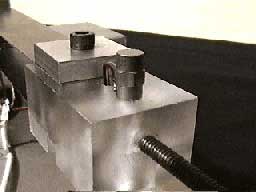






This section is divided into four areas:
In the study of physical systems, it is often desirable to observe the motion of a system and, in particular, its acceleration. Accelerometers can be described as a combination of two transducers -- the primary transducer, typically a single-degree-of-freedom vibrating mass, or seismic mass, which converts the acceleration into a displacement, and a secondary transducer which converts the displacement of the seismic mass into an electric signal.
As our accelerometer reacts to motion, it places the piezoelectric crystal into compression or tension, which causes a surface charge to develop on the crystal. The charge is proportional to the displacement of the crystal. As the large body moves, the mass of the accelerometer will move with an inertial response. The piezoelectric crystal acts as the spring to provide a resisting force and damping. As the seismic mass moves, it places a piezoelectric crystal into compression or tension, which causes a surface charge to develop on the crystal which is proportional to the motion.